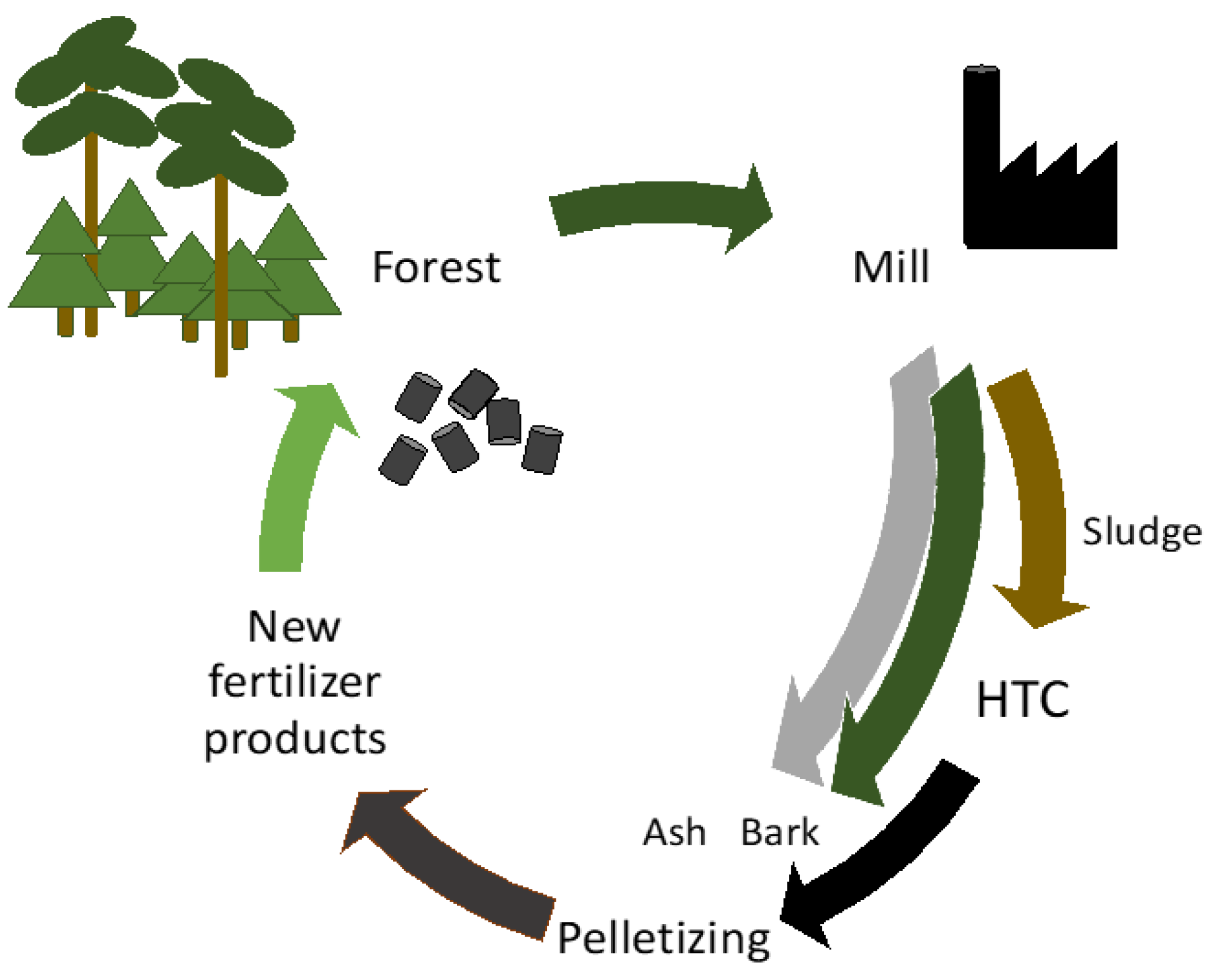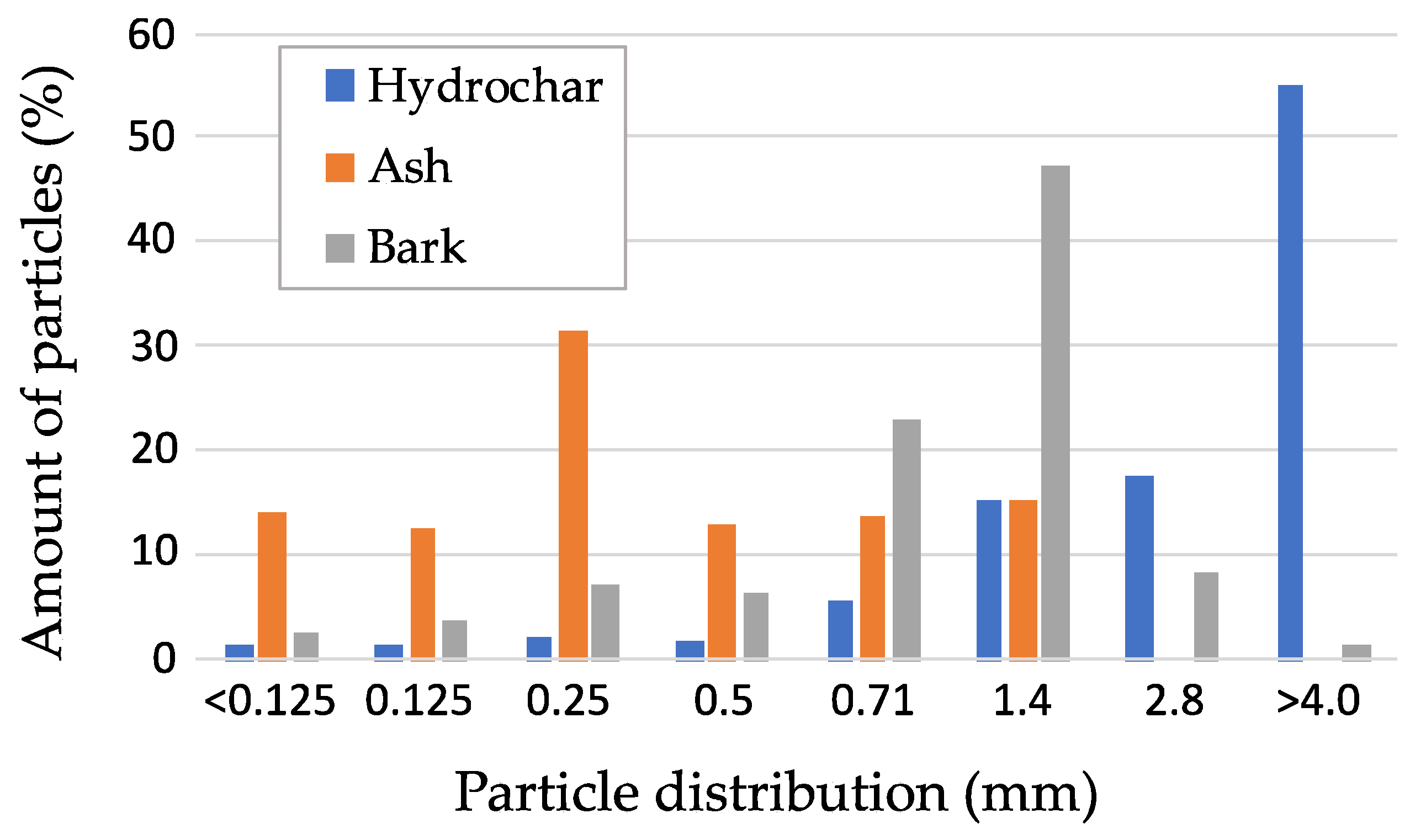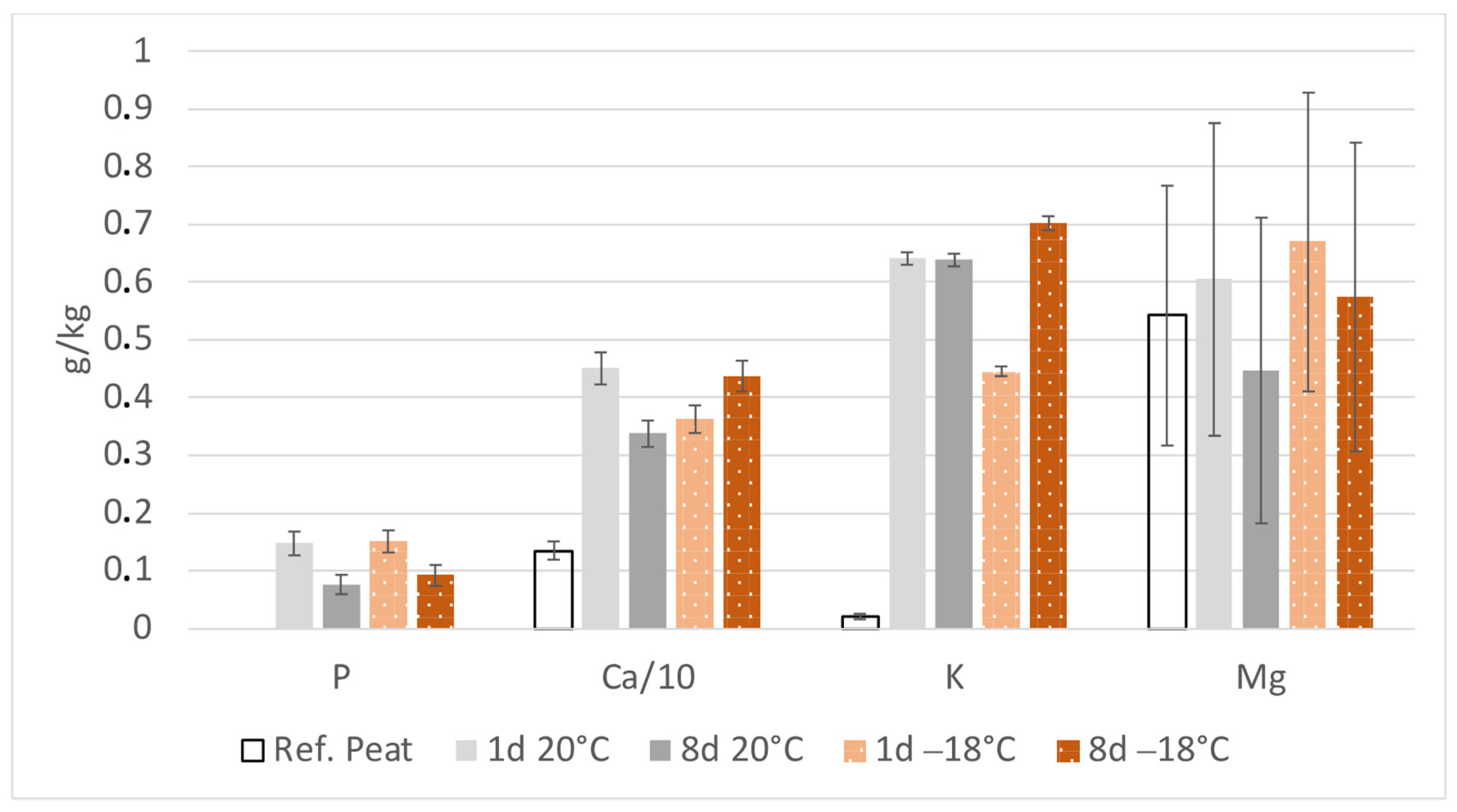Forest Industrial Waste Materials Upgraded to Fertilizer Pellets for Forest Soil
Abstract
:1. Introduction
2. Materials and Methods
2.1. Materials Used and Distribution of the Blends
Physical Properties of the Material
2.2. Pelletizing and Pellet Physical Properties
2.2.1. Pelletizing
2.2.2. Physical Pellet Properties
2.2.3. Fourier Transform Infrared Spectroscopic Analysis (FT-IR)
2.3. Pellet Properties after Being Spread in the Forest
- (0)
- The control, not stored in moist peat.
- (1)
- Stored wet 1 day at room temperature.
- (2)
- Stored wet 8 days at room temperature.
- (3)
- Stored wet 1 day at room temperature and then stored in a freezer at −18 °C for 1 day.
- (4)
- Stored wet 1 day at room temperature and stored in a freezer at −18 °C for 7 days.
3. Results and Discussion
3.1. Distribution Ratio between Hydrochar Bark and Ash
3.2. Pelletizing and Pellet Properties
Fourier Transform Infrared Spectroscopic Analysis (FT-IR)
3.3. Pellet Properties in the Forest-like Environment
3.4. Future Possibilities for Sustainable Resource Recovery
4. Conclusions
Author Contributions
Funding
Institutional Review Board Statement
Informed Consent Statement
Data Availability Statement
Acknowledgments
Conflicts of Interest
References
- Skogsindustrierna.se. Om Skogsindustrin/Branschstatistik/Skogsindustrins Virkesforsörjning; Skogsindustrierna: Stockholm, Sweden, 2023. [Google Scholar]
- Drott, A.; Anderson, S.; Eriksson, H. Regler Och Rekommendationer for Skogsbransleuttag Och Kompensationsatgarder. Kunskaplsunderlag; Skogsindustrierna: Stockholm, Sweden, 2019. [Google Scholar]
- Wendołowski, M. Fertilizer Carbon Footprint Calculator. Fertilizer FOCUS. 2019. Available online: https://www.fertilizerseurope.com/wp-content/uploads/2019/11/Fertilizer-Carbon-Footprint-Calculator-Fertilizer-Focus-Magazine.pdf (accessed on 19 March 2024).
- Ding, Y.; Liu, Y.; Liu, S.; Li, Z.; Tan, X.; Huang, X.; Zeng, G.; Zhou, L.; Zheng, B. Biochar to improve soil fertility. A review. Agron. Sustain. Dev. 2016, 36, 36. [Google Scholar] [CrossRef]
- Mohammadi, A.; Sandberg, M.; Venkatesh, G.; Eskandari, S.; Dalgaard, T.; Joseph, S.; Granström, K. Environmental analysis of producing biochar and energy recovery from pulp and paper mill biosludge. J. Ind. Ecol. 2019, 23, 1039–1051. [Google Scholar] [CrossRef]
- Shen, Y. A review on hydrothermal carbonization of biomass and plastic wastes to energy products. Biomass Bioenergy 2020, 134, 105479. [Google Scholar] [CrossRef]
- Gallant, R.; Farooque, A.A.; He, S.; Kang, K.; Hu, Y. A Mini-Review: Biowaste-Derived Fuel Pellet by Hydrothermal Carbonization Followed by Pelletizing. Sustainability 2022, 14, 12530. [Google Scholar] [CrossRef]
- Fernando, F.; Belda, R.M. Biochar versus hydrochar as growth media constituents for ornamental plant cultivation. Sci. Agric. 2018, 75, 304–312. [Google Scholar]
- Fornes, F.; Belda, R.M. Use of raw and acidified biochar as consotituents of growth media for forest seedling production. New Forest 2019, 50, 1063–1086. [Google Scholar] [CrossRef]
- Hao, S.; Zhu, X.; Liu, Y.; Qian, F.; Fang, Z.; Shi, Q.; Zhang, S.; Chen, J.; Ren, Z.J. Production temperature effects on the structure of hydrochar-derived dissolved organic matter and associated toxicity. Environ. Sci. Technol. 2018, 52, 7486–7495. [Google Scholar] [CrossRef] [PubMed]
- Baronti, S.; Alberti, G.; Camin, F.; Criscuoli, I.; Genesio, L.; Mass, R.; Vaccari, F.; Luca, Z.; Franco, M. Hydrochar enhances growth of poplar for bioenergywhile marginally contributing to direct soil carbonsequestration. Bioenergy 2017, 9, 1618–1626. [Google Scholar]
- Eskandari, S.; Mohammadi, A.; Sandberg, M.; Eckstein, R.L.; Hedberg, K.; Granström, K. Hydrochar-amended substrates for production of containerized pine tree seedlings under different fertilization regimes. Agronomy 2019, 9, 350. [Google Scholar] [CrossRef]
- Tumuluru, J.S.; Wright, C.T.; Hess, J.R.; Kenney, K.L. A review of biomass densification systems to develop uniform feedstock commodities for bioenergy application. Biofuels Bioprod. Biorefining 2011, 5, 683–707. [Google Scholar] [CrossRef]
- Tumuluru, J.S. Pelleting of pine and switchgrass blends: Effect of process variables and blend ratio on the pellet quality and energy consumption. Energies 2019, 12, 1198. [Google Scholar] [CrossRef]
- Whittaker, C.; Shield, I. Factors affecting wood, energy grass and straw pellet durability—A review. Renew. Sustain. Energy Rev. 2017, 71, 1–11. [Google Scholar] [CrossRef]
- Kaliyan, N.; Morey, R.V. Natural binders and solid bridge type binding mechanisms in briquettes and pellets made from corn stover and switchgrass. Bioresour. Technol. 2010, 101, 1082–1090. [Google Scholar] [CrossRef]
- Wilson, T.O. Factors Affecting Wood Pellet Durability. Master’s Thesis, The Pennsylvania State University, State College, PA, USA, 2010. [Google Scholar]
- Stelte, W.; Holm, J.K.; Sanadi, A.R.; Barsberg, S.; Ahrenfeldt, J.; Henriksen, U.B. A study of bonding and failure mechanisms in fuel pellets from different biomass resources. Biomass Bioenergy 2011, 35, 910–918. [Google Scholar] [CrossRef]
- Stelte, W.; Clemons, C.; Holm, J.K.; Ahrenfeldt, J.; Henriksen, U.B.; Sanadi, A.R. Fuel Pellets from Wheat Straw: The Effect of Lignin Glass Transition and Surface Waxes on Pelletizing Properties. Bioenergy Res. 2012, 5, 450–458. [Google Scholar] [CrossRef]
- Stelte, W.; Clemons, C.; Holm, J.K.; Ahrenfeldt, J.; Henriksen, U.B.; Sanadi, A.R. Thermal transitions of the amorphous polymers in wheat straw. Ind. Crops Prod. 2011, 34, 1053–1056. [Google Scholar] [CrossRef]
- Frodeson, S.; Henriksson, G.; Berghel, J. Pelletizing Pure Biomass Substances to Investigate the Mechanical Properties and Bonding Mechanisms. BioResources 2018, 21, 1202–1222. [Google Scholar] [CrossRef]
- Frodeson, S.; Lindén, P.; Henriksson, G.; Berghel, J. Compression of Biomass Substances—A Study on Springback Effects and Color Formation in Pellet Manufacture. Appl. Sci. 2019, 9, 4302. [Google Scholar] [CrossRef]
- Mohammadi, A. Overview of the benefits and challenges associated with pelletizing biochar. Processes 2021, 9, 1591. [Google Scholar] [CrossRef]
- Reza, M.T.; Lynam, J.G.; Vasquez, V.R.; Coronella, C.J. Pelletization of biochar from hydrothermally carbonized wood. Environ. Prog. Sustain. Energy 2012, 31, 225–234. [Google Scholar] [CrossRef]
- Fakkaew, K.; Koottatep, T.; Jairuang, S.; Polprasert, C. Hydrochar pellet produced from hydrothermal carbonization of fecal sludge. Biomass Convers. Biorefinery 2021, 13, 5157–5164. [Google Scholar] [CrossRef]
- Mittapalli, S.; Sharma, H.B.; Dubey, B.K. Hydrothermal carbonization of anaerobic granular sludge and co-pelletization of hydrochar with yard waste. Bioresour. Technol. Rep. 2021, 14, 100691. [Google Scholar] [CrossRef]
- Ul Saqib, N.; Sarmah, A.K.; Baroutian, S. Effect of temperature on the fuel properties of food waste and coal blend treated under co-hydrothermal carbonization. Waste Manag. 2019, 89, 236–246. [Google Scholar] [CrossRef] [PubMed]
- Berghel, J.; Ståhl, M.; Frodeson, S.; Pichler, W.; Weigl-Kuska, M. A comparison of relevant data and results from single pellet press research is Mission Impossible: A review. Bioresour. Technol. Rep. 2022, 18, 101054. [Google Scholar] [CrossRef]
- Tumuluru, J.S.; Fillerup, E. Briquetting characteristics of woody and herbaceous biomass blends: Impact on physical properties, chemical composition, and calorific value. Biofuels Bioprod. Biorefining 2020, 14, 1105–1124. [Google Scholar] [CrossRef]
- Tumuluru, J.S. Explore the Potential to Formulate Feedstock Blends from Diverse Biomass inputs for Improved Processing Performance at Lower Costs; Idaho National Lab. (INL): Idaho Falls, ID, USA, 2021. [Google Scholar]
- Krogell, J.; Holmbom, B.; Pranovich, A.; Hemming, J.; Willför, S. Extraction and chemical characterization of Norway spruce inner and outer bark. Nord. Pulp Pap. Res. J. 2012, 27, 6–17. [Google Scholar] [CrossRef]
- Obernberger, I.; Thek, G. The Pellet Handbook; Earthscan Ltd.: Calgary, AB, Canada, 2010. [Google Scholar]
- Frodeson, S.; Anukam, A.I.; Berghel, J.; Ståhl, M.; Lasanthi Kudahettige Nilsson, R.; Henriksson, G.; Bosede Aladejana, E. Densification of Wood—Influence on Mechanical and Chemical Properties when 11 Naturally Occurring Substances in Wood Are Mixed with Beech and Pine. Energies 2021, 14, 5895. [Google Scholar] [CrossRef]
- Xia, X.; Xiao, H.; Yang, Z.; Xie, X.; Bhimani, J. Pelletization characteristics of the hydrothermal pretreated rice straw with added binders. Arab. J. Sci. Eng. 2018, 43, 4811–4820. [Google Scholar] [CrossRef]
- BS-EN 16174; Sludge, treated biowaste and soil. Digestion of aqua regia soluble fractions of elements. British-Adopted European Standard: Northampton, UK, 2012.
- SS-EN 16171; Sludge, Treated Biowaste And Soil—Determination Of Elements Using Inductively Coupled Plasma Mass Spectrometry (ICP-MS). Swedish Standards Institute: Stockholm, Sweden, 2016.
- ISO 11885:2007; Water Quality—Determination of Selected Elements by Inductively Coupled Plasma Optical Emission Spectrometry (ICP-OES). ISO: Geneva, Switzerland, 2007.
- Hellsten, S.; Helmisaari, H.-S.; Melin, Y.; Skovsgaard, J.P.; Wängberg, I.; Kaakinen, S.; Kukkola, M.; Saarsalmi, A.; Petersson, H.; Akselsson, C. Halter av Baskatjoner, Fosfor Och Kväve i Stubbar i Sverige, Finland och Danmark; IVL Svenska Miljöinstitutet: Stockholm, Sweden, 2009. [Google Scholar]
- ISO 17828; Solid Biofuels—Determination of Bulk Density. ISO: Geneva, Switzerland, 2015.
- Igathinathane, C.; Tumuluru, J.S.; Sokhansanj, S.; Bi, X.; Lim, C.J.; Melin, S.; Mohammad, E. Simple and inexpensive method of wood pellets macro-porosity measurement. Bioresour. Technol. 2010, 101, 6528–6537. [Google Scholar] [CrossRef]
- ISO 17831-1; Solid Biofuels—Determination of Mechanical Durability of Pellets and Briquettes. ISO: Geneva, Switzerland, 2015.
- SS EN 14774-1; Solid Biofuels—Determination of Moisture Content-Oven Dry Method-Part 1: Total moisture—Reference method. Swedish Standards Institute: Stockholm, Sweden, 2009.
- Mohammadi, A.; Anukam, A.I.; Granström, K.; Eskandari, S.; Zywalewska, M.; Sandberg, M.; Aladejana, E.B. Effects of wood ash on physicochemical and morphological characteristics of sludge-derived hydrochar pellets relevant to soil and energy applications. Biomass Bioenergy 2022, 163, 106531. [Google Scholar] [CrossRef]
- Anukam, A.I.; Berghel, J.; Frodeson, S.; Famewo, E.B.; Nyamukamba, P. Characterization of pure and blended pellets made from Norway spruce and Pea starch: A comparative study of bonding mechanism relevant to quality. Energies 2019, 12, 4415. [Google Scholar] [CrossRef]
- Anukam, A.; Berghel, J.; Henrikson, G.; Frodeson, S.; Ståhl, M. A review of the mechanism of bonding in densified biomass pellets. Renew. Sustain. Energy Rev. 2021, 148, 111249. [Google Scholar] [CrossRef]
- Anukam, A.I.; Berghel, J.; Famewo, E.B.; Frodeson, S. Improving the Understanding of the Bonding Mechanism of Primary Components of Biomass Pellets through the Use of Advanced Analytical Instruments. J. Wood Chem. Technol. 2020, 40, 15–32. [Google Scholar] [CrossRef]
- Toscano, G.; Maceratesi, V.; Leoni, E.; Stipa, P.; Laudadio, E.; Sabbatini, S. FTIR spectroscopy for determination of the raw materials used in wood pellet production. Fuel 2022, 313, 123017. [Google Scholar] [CrossRef]
- Weindorf, D.C.; Zhu, Y.; Haggard, B.; Lofton, J.; Chakraborty, S.; Bakr, N.; Zhang, W.; Weindorf, W.C.; Legoria, M. Enhanced pedon horizonation using portable X-ray fluorescence spectrometry. Soil Sci. Soc. Am. J. 2012, 76, 522–531. [Google Scholar] [CrossRef]
- López-Núñez, R. Portable X-ray Fluorescence Analysis of Organic Amendments: A Review. Appl. Sci. 2022, 12, 6944. [Google Scholar] [CrossRef]









| Substance | Unit | Hydrochar | Biofuel Ash | Spruce Bark |
|---|---|---|---|---|
| N | g/kg | 37 | 0 | 4.5 |
| P | g/kg | 17 | 7.1 | 0.35 |
| Ca | g/kg | 13 | 150 | 9 |
| K | g/kg | 1.3 | 19 | 1.7 |
| Mg | g/kg | 1.8 | 12 | 0.4 |
| As | mg/kg | na | 3.8 | na |
| Pb | mg/kg | 4.2 | 39 | 1.92 |
| Cd | mg/kg | 1.2 | 8.1 | 0.12 |
| Co | mg/kg | 9.8 | 6.3 | na |
| Cu | mg/kg | 22 | 66 | 1.05 |
| Cr | mg/kg | 23 | 71 | 0.25 |
| Ni | mg/kg | 34 | 31 | 0.63 |
| V | mg/kg | 16 | 42 | na |
| Zn | mg/kg | 370 | 1200 | 0.08 |
| Hg | mg/kg | 0.09 | 0.32 | na |
| Amount of Nitrogen per Hectare | To Reach 150 kg N/Hectare | To Reach 120 kg N/Hectare | ||
|---|---|---|---|---|
| Test series | 50/50 | 45/10/45 | 50/50 | 45/10/45 |
| Ton pellets/hectare | 8.1 | 8.8 | 6.5 | 7.0 |
| m3 pellets/hectare | 8.9 | 9.9 | 7.1 | 7.9 |
| Criteria 3 Ton Ash/ha | Criteria 150 kg N/ha | Criteria 120 kg N/ha | ||||
|---|---|---|---|---|---|---|
| Substance | Units | Criteria | Hydrochar/Ash 50/50 | Hydrochar/Ash/Bark 45/10/45 | Hydrochar/Ash 50/50 | Hydrochar/Ash/Bark 45/10/45 |
| N | kg/ha | - | 150.0 | 150.0 | 119.9 | 119.7 |
| P | kg/ha | >21 | 97.7 | 95.4 | 78.1 | 76.2 |
| Ca | kg/ha | >375 | 660.8 | 651.3 | 528.1 | 519.8 |
| K | kg/ha | >90 | 82.3 | 81.6 | 65.8 | 65.1 |
| Mg | kg/ha | >45 | 55.9 | 54.8 | 44.7 | 43.8 |
| As | g/ha | <90 | 15.4 | 15.0 | 12.3 | 12.0 |
| Pb | g/ha | <900 | 175.1 | 172.2 | 140.0 | 137.4 |
| Cd | g/ha | <90 | 37.7 | 36.8 | 30.1 | 29.4 |
| Co | g/ha | <1200 | 65.3 | 63.6 | 52.2 | 50.7 |
| Cu | g/ha | <600 | 356.8 | 348.3 | 285.1 | 277.9 |
| Cr | g/ha | <600 | 381.1 | 371.3 | 304.6 | 296.3 |
| Ni | g/ha | <210 | 263.5 | 257.1 | 210.6 | 205.2 |
| V | g/ha | <210 | 235.1 | 228.9 | 187.9 | 182.7 |
| Zn | g/ha | 1500–21,000 | 6364.9 | 6197.4 | 5086.8 | 4945.6 |
| Hg | g/ha | <9 | 1.7 | 1.6 | 1.3 | 1.3 |
| Bulk Density (kg/m3) | ||
|---|---|---|
| Mean | Stdav | |
| Hydrochar | 527.5 | 5.2 |
| Ash | 397.6 | 10.1 |
| Bark | 342.7 | 3.1 |
| 50/50 | 45/10/45 | |
|---|---|---|
| Roller frequency (Hz) | 48.4 | 48.2 |
| Die temperature (°C) | 77.9 ± 2.3 | 76.2 ± 1.8 |
| Power (kW) | 1.94 ± 0.1 | 1.6 ± 0.1 |
| Loose Density | Bulk Density | Moisture | ||||||
|---|---|---|---|---|---|---|---|---|
| (kg/m3) | (kg/m3) | During Pelletization | Pellets | |||||
| Mean | Stdav | Mean | Stdav | Before (%) | Warm Pellets (%) | Evaporated (kgH2O/kgDS) | (%) | |
| 50/50 | 774.4 | 5.7 | 909.5 | 14.4 | 17.5 | 13.7 | 0.25 | 6.19 |
| 45/10/45 | 757.4 | 5.2 | 886.4 | 7.0 | 17.9 | 13.5 | 0.27 | 5.91 |
| Solid Pellet Density (kg/m3) | Macro Porosity | |||||
|---|---|---|---|---|---|---|
| Loose (%) | Loose (%) | |||||
| Mean | Stdav | Mean | Stdav | Mean | Stdav | |
| 50/50 | 774.4 | 5.7 | 53.3 | 0.5 | 50.5 | 0.7 |
| 45/10/45 | 757.4 | 5.2 | 49.5 | 3.1 | 46.6 | 2.9 |
| P | Ca | Mg | K | Cu | Cr | Zn | |
|---|---|---|---|---|---|---|---|
| p-value | 0.0003 | 1.58 × 10−6 | 0.749 | 5.21 × 10−6 | 0.01 | 0.093 | 0.0009 |
| Leached | 0.8‰ | 3.7‰ | 0.5‰ | 6.7‰ | 1.38‰ | 2.98‰ | 1.39‰ |
Disclaimer/Publisher’s Note: The statements, opinions and data contained in all publications are solely those of the individual author(s) and contributor(s) and not of MDPI and/or the editor(s). MDPI and/or the editor(s) disclaim responsibility for any injury to people or property resulting from any ideas, methods, instructions or products referred to in the content. |
© 2024 by the authors. Licensee MDPI, Basel, Switzerland. This article is an open access article distributed under the terms and conditions of the Creative Commons Attribution (CC BY) license (https://creativecommons.org/licenses/by/4.0/).
Share and Cite
Sandberg, M.; Frodeson, S.; Brunzell, L.; Tumuluru, J.S. Forest Industrial Waste Materials Upgraded to Fertilizer Pellets for Forest Soil. Sustainability 2024, 16, 2868. https://doi.org/10.3390/su16072868
Sandberg M, Frodeson S, Brunzell L, Tumuluru JS. Forest Industrial Waste Materials Upgraded to Fertilizer Pellets for Forest Soil. Sustainability. 2024; 16(7):2868. https://doi.org/10.3390/su16072868
Chicago/Turabian StyleSandberg, Maria, Stefan Frodeson, Lena Brunzell, and Jaya Shankar Tumuluru. 2024. "Forest Industrial Waste Materials Upgraded to Fertilizer Pellets for Forest Soil" Sustainability 16, no. 7: 2868. https://doi.org/10.3390/su16072868





